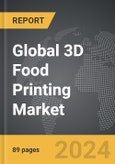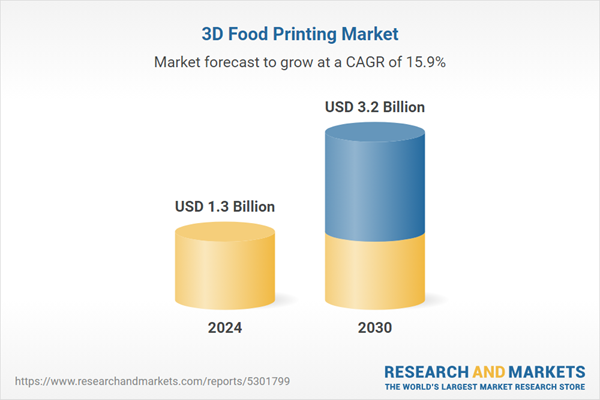Global 3D Food Printing Market - Key Trends and Drivers Summarized
What Is 3D Food Printing and How Does It Work?
3D food printing is an emerging technology that combines culinary creativity with advanced printing techniques, offering a novel approach to food preparation. Similar to other forms of 3D printing, this process uses digitally designed models to create edible structures by layering ingredients in precise, customizable patterns. The printer works by extruding various food ingredients, often in paste, liquid, or powder form, through specialized nozzles. These ingredients can range from pureed fruits and vegetables to proteins, starches, and even chocolate. The design of the food product is first created using computer-aided design (CAD) software, which instructs the printer on how to layer the ingredients to form complex shapes or textures. Depending on the type of printer, the food may also undergo additional cooking processes, such as baking or freezing, directly within the machine. This technology opens the door to endless possibilities in terms of food customization, nutrition control, and artistic presentation. From creating intricate desserts and gourmet dishes to producing specialized meals for individuals with dietary restrictions, 3D food printing represents a fusion of culinary art and cutting-edge technology.How Is 3D Food Printing Transforming the Food Industry?
3D food printing is beginning to have a transformative impact on the food industry, particularly in areas such as customization, sustainability, and the development of innovative food products. One of the most significant advantages of 3D food printing is its ability to tailor food to individual preferences and dietary needs. Chefs, food manufacturers, and even home users can customize flavors, textures, and nutritional content with high precision, catering to specific health goals or dietary restrictions such as low-sodium or gluten-free diets. This level of customization also extends to creating visually stunning, geometrically intricate food items that would be impossible to achieve using traditional cooking methods. Beyond high-end gastronomy, 3D food printing is also gaining traction in the healthcare and elderly care sectors, where the ability to produce nutritious, easy-to-consume meals for patients with dysphagia or other eating difficulties can improve quality of life. Sustainability is another area where 3D food printing is making a mark. The technology allows for the use of alternative ingredients, such as plant-based proteins, algae, or even insect-based powders, which can be mixed and printed into familiar food formats, helping to reduce reliance on traditional meat sources and lowering the environmental impact of food production. Additionally, 3D food printing significantly reduces food waste by enabling portion control and the use of byproducts or surplus ingredients that might otherwise be discarded. In these ways, 3D food printing is reshaping the future of food production, offering innovative solutions to global food challenges.What Are the Challenges and Limitations of 3D Food Printing?
Despite its potential, 3D food printing faces several challenges and limitations that currently restrict its broader adoption. One of the main technical challenges is the limitation of ingredients that can be used in the printing process. For food to be printable, it must be in a paste, powder, or liquid form that can be extruded through the printer’s nozzle, which limits the range of textures and flavors that can be achieved. Complex foods or ingredients that do not readily adapt to this format may require additional processing, which can reduce their nutritional value or alter their taste. Another issue is the speed of production. While 3D printing can create intricate, personalized food items, it is generally slower than traditional cooking methods, especially when producing larger quantities. This poses a barrier for large-scale food production or quick-service applications, where speed and efficiency are critical. Furthermore, the cost of 3D food printers and the materials required to operate them remains relatively high, making the technology inaccessible for many restaurants, food manufacturers, or consumers. There are also regulatory challenges to consider. Food safety standards for 3D-printed food have yet to be fully established, particularly in terms of ensuring the cleanliness and quality of printed meals. These factors, combined with the lack of widespread consumer familiarity with the technology, suggest that while 3D food printing has great potential, there is still considerable progress to be made before it becomes mainstream in the global food industry.What’s Fueling the Rapid Expansion of the 3D Food Printing Market?
The growth in the 3D food printing market is driven by several key factors, reflecting the evolving needs and preferences of both consumers and industries. First and foremost, the demand for personalized nutrition is a significant driver of the market. Consumers today are increasingly seeking food products that are tailored to their specific dietary needs, whether for health reasons, fitness goals, or lifestyle choices such as veganism or keto diets. 3D food printing allows for precise customization of ingredients, macronutrient profiles, and portion sizes, making it an ideal solution for personalized meal planning. In addition, there is a growing interest in sustainable food production, particularly in response to environmental concerns about conventional agriculture and food waste. 3D food printing facilitates the use of alternative proteins, such as plant-based or insect-derived ingredients, which can be combined in ways that mimic traditional meat textures and flavors while significantly reducing the carbon footprint of food production. This technology also offers opportunities to repurpose surplus ingredients or food byproducts that would otherwise be wasted, contributing to a more circular food economy. The food service and hospitality industries are also embracing 3D printing technology as a means to create unique, artistic culinary experiences that can differentiate their offerings in a competitive market. Chefs can experiment with intricate designs and presentations, enhancing the visual appeal of dishes and providing customers with memorable dining experiences. Lastly, increased investment from food manufacturers, tech companies, and research institutions is accelerating the development of more advanced and affordable 3D food printers. Governments and academic institutions are also supporting initiatives aimed at integrating 3D food printing into school cafeterias, hospitals, and space missions, recognizing its potential to address issues of food security and efficiency. These factors, combined with continuous advancements in technology and materials, are propelling the growth of the 3D food printing market at a rapid pace.Report Scope
The report analyzes the 3D Food Printing market, presented in terms of units. The analysis covers the key segments and geographic regions outlined below.Segments: Ingredient (Fruits & Vegetables, Dairy Products, Carbohydrates & Proteins, Chocolate & Sugars, Other Ingredients); End-Use (Confectionery Products, Bakery Products, Snack Products, Other End-Uses).
Geographic Regions/Countries: World; United States; Canada; Japan; China; Europe (France; Germany; Italy; United Kingdom; and Rest of Europe); Asia-Pacific; Rest of World.
Key Insights:
- Market Growth: Understand the significant growth trajectory of the Fruits & Vegetables segment, which is expected to reach US$1.2 Billion by 2030 with a CAGR of a 17.4%. The Dairy Products segment is also set to grow at 15.8% CAGR over the analysis period.
- Regional Analysis: Gain insights into the U.S. market, valued at $365.1 Million in 2024, and China, forecasted to grow at an impressive 14.9% CAGR to reach $475.8 Million by 2030. Discover growth trends in other key regions, including Japan, Canada, Germany, and the Asia-Pacific.
Why You Should Buy This Report:
- Detailed Market Analysis: Access a thorough analysis of the Global 3D Food Printing Market, covering all major geographic regions and market segments.
- Competitive Insights: Get an overview of the competitive landscape, including the market presence of major players across different geographies.
- Future Trends and Drivers: Understand the key trends and drivers shaping the future of the Global 3D Food Printing Market.
- Actionable Insights: Benefit from actionable insights that can help you identify new revenue opportunities and make strategic business decisions.
Key Questions Answered:
- How is the Global 3D Food Printing Market expected to evolve by 2030?
- What are the main drivers and restraints affecting the market?
- Which market segments will grow the most over the forecast period?
- How will market shares for different regions and segments change by 2030?
- Who are the leading players in the market, and what are their prospects?
Report Features:
- Comprehensive Market Data: Independent analysis of annual sales and market forecasts in US$ Million from 2024 to 2030.
- In-Depth Regional Analysis: Detailed insights into key markets, including the U.S., China, Japan, Canada, Europe, Asia-Pacific, Latin America, Middle East, and Africa.
- Company Profiles: Coverage of players such as 3D Systems, 8 Print2taste GmbH, Barilla, Beehex, Candyfab and more.
- Complimentary Updates: Receive free report updates for one year to keep you informed of the latest market developments.
Some of the 34 companies featured in this 3D Food Printing market report include:
- 3D Systems
- 8 Print2taste GmbH
- Barilla
- Beehex
- Candyfab
- Choc Edge
- Dovetailed
- Modern Meadow, Inc.
- Natural Machines
- North Branch Everbright
- Nu Food
- Print2taste GmbH
- SMRC
- Systems and Materials Research Corporation
- TNO
Tariff Impact Analysis: Key Insights for 2025
Global tariff negotiations across 180+ countries are reshaping supply chains, costs, and competitiveness. This report reflects the latest developments as of April 2025 and incorporates forward-looking insights into the market outlook.The analysts continuously track trade developments worldwide, drawing insights from leading global economists and over 200 industry and policy institutions, including think tanks, trade organizations, and national economic advisory bodies. This intelligence is integrated into forecasting models to provide timely, data-driven analysis of emerging risks and opportunities.
What’s Included in This Edition:
- Tariff-adjusted market forecasts by region and segment
- Analysis of cost and supply chain implications by sourcing and trade exposure
- Strategic insights into geographic shifts
Buyers receive a free July 2025 update with:
- Finalized tariff impacts and new trade agreement effects
- Updated projections reflecting global sourcing and cost shifts
- Expanded country-specific coverage across the industry
Table of Contents
Companies Mentioned (Partial List)
A selection of companies mentioned in this report includes, but is not limited to:
- 3D Systems
- 8 Print2taste GmbH
- Barilla
- Beehex
- Candyfab
- Choc Edge
- Dovetailed
- Modern Meadow, Inc.
- Natural Machines
- North Branch Everbright
- Nu Food
- Print2taste GmbH
- SMRC
- Systems and Materials Research Corporation
- TNO
Table Information
| Report Attribute | Details |
|---|---|
| No. of Pages | 89 |
| Published | April 2025 |
| Forecast Period | 2024 - 2030 |
| Estimated Market Value ( USD | $ 1.3 Billion |
| Forecasted Market Value ( USD | $ 3.2 Billion |
| Compound Annual Growth Rate | 15.9% |
| Regions Covered | Global |









